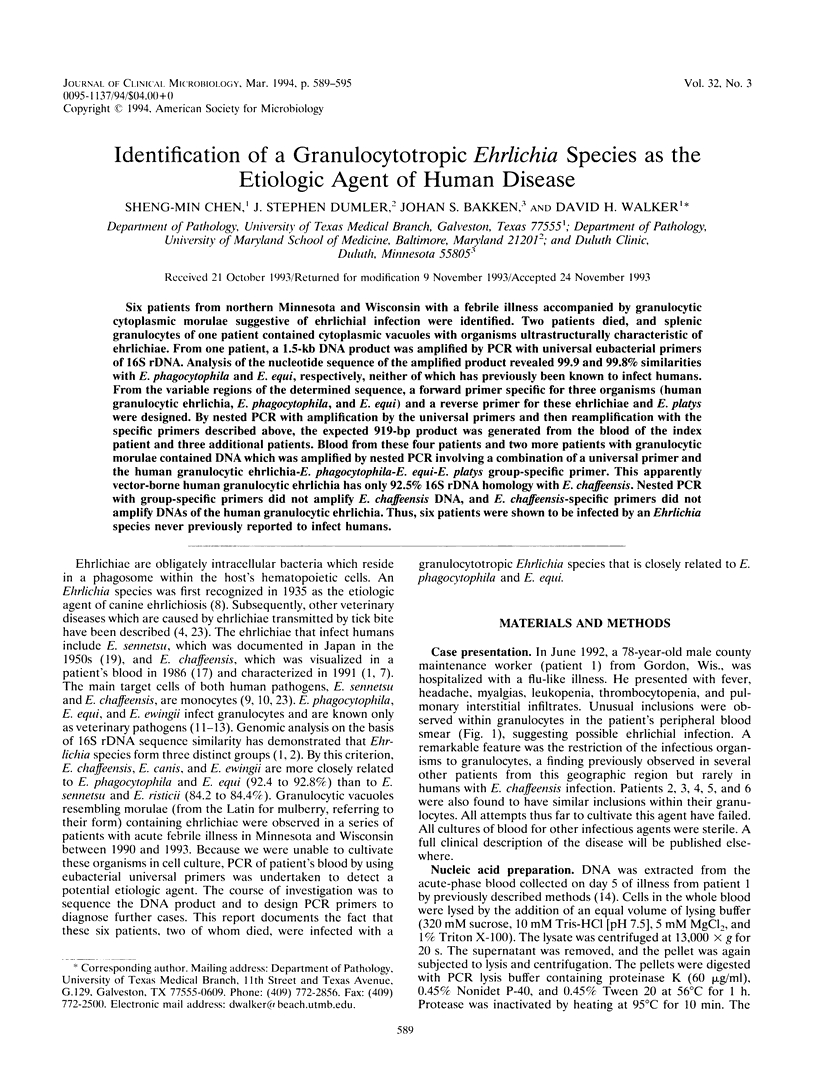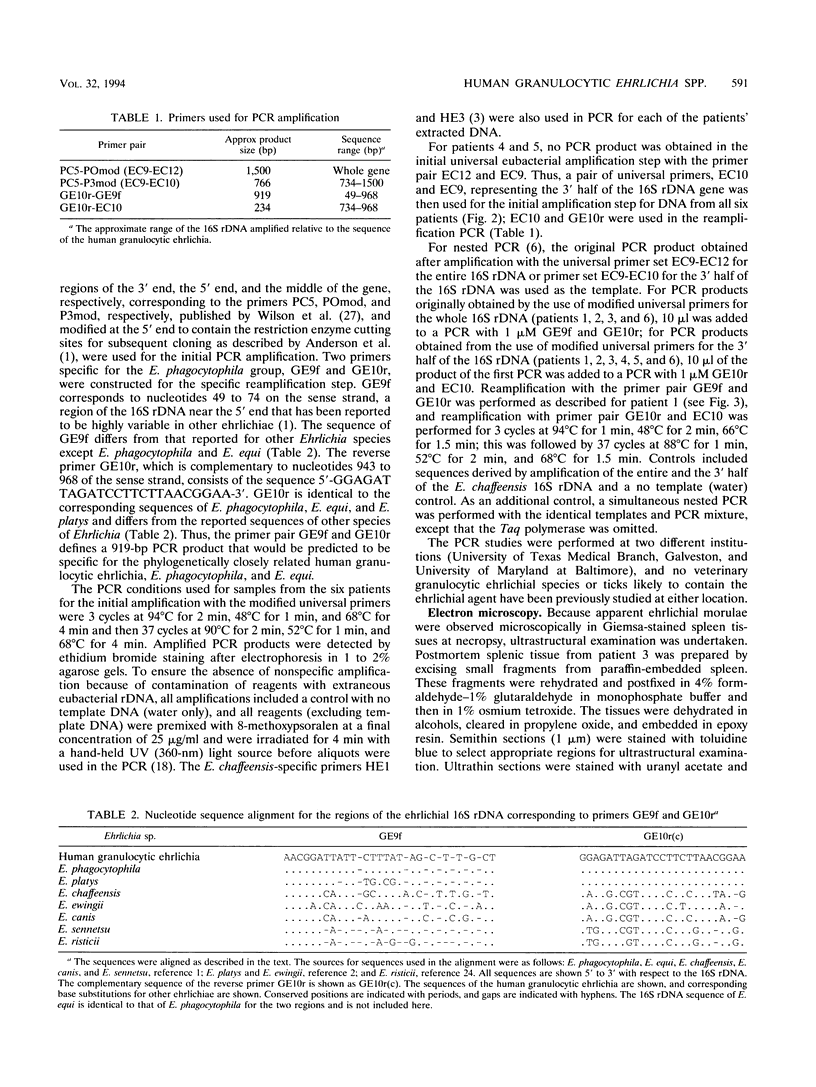Abstract
Six patients from northern Minnesota and Wisconsin with a febrile illness accompanied by granulocytic cytoplasmic morulae suggestive of ehrlichial infection were identified. Two patients died, and splenic granulocytes of one patient contained cytoplasmic vacuoles with organisms ultrastructurally characteristic of ehrlichiae. From one patient, a 1.5-kb DNA product was amplified by PCR with universal eubacterial primers of 16S rDNA. Analysis of the nucleotide sequence of the amplified product revealed 99.9 and 99.8% similarities with E. phagocytophila and E. equi, respectively, neither of which has previously been known to infect humans. From the variable regions of the determined sequence, a forward primer specific for three organisms (human granulocytic ehrlichia, E. phagocytophila, and E. equi) and a reverse primer for these ehrlichiae and E. platys were designed. By nested PCR with amplification by the universal primers and then reamplification with the specific primers described above, the expected 919-bp product was generated from the blood of the index patient and three additional patients. Blood from these four patients and two more patients with granulocytic morulae contained DNA which was amplified by nested PCR involving a combination of a universal primer and the human granulocytic ehrlichia-E. phagocytophila-E. equi-E. platys group-specific primer. This apparently vector-borne human granulocytic ehrlichia has only 92.5% 16S rDNA homology with E. chaffeensis. Nested PCR with group-specific primers did not amplify E. chaffeensis DNA, and E. chaffeensis-specific primers did not amplify DNAs of the human granulocytic ehrlichia. Thus, six patients were shown to be infected by an Ehrlichia species never previously reported to infect humans.
Full text
PDF






Images in this article
Selected References
These references are in PubMed. This may not be the complete list of references from this article.
- Anderson B. E., Dawson J. E., Jones D. C., Wilson K. H. Ehrlichia chaffeensis, a new species associated with human ehrlichiosis. J Clin Microbiol. 1991 Dec;29(12):2838–2842. doi: 10.1128/jcm.29.12.2838-2842.1991. [DOI] [PMC free article] [PubMed] [Google Scholar]
- Anderson B. E., Greene C. E., Jones D. C., Dawson J. E. Ehrlichia ewingii sp. nov., the etiologic agent of canine granulocytic ehrlichiosis. Int J Syst Bacteriol. 1992 Apr;42(2):299–302. doi: 10.1099/00207713-42-2-299. [DOI] [PubMed] [Google Scholar]
- Anderson B. E., Sumner J. W., Dawson J. E., Tzianabos T., Greene C. R., Olson J. G., Fishbein D. B., Olsen-Rasmussen M., Holloway B. P., George E. H. Detection of the etiologic agent of human ehrlichiosis by polymerase chain reaction. J Clin Microbiol. 1992 Apr;30(4):775–780. doi: 10.1128/jcm.30.4.775-780.1992. [DOI] [PMC free article] [PubMed] [Google Scholar]
- Anziani O. S., Ewing S. A., Barker R. W. Experimental transmission of a granulocytic form of the tribe Ehrlichieae by Dermacentor variabilis and Amblyomma americanum to dogs. Am J Vet Res. 1990 Jun;51(6):929–931. [PubMed] [Google Scholar]
- Brouqui P., Dumler J. S., Raoult D., Walker D. H. Antigenic characterization of ehrlichiae: protein immunoblotting of Ehrlichia canis, Ehrlichia sennetsu, and Ehrlichia risticii. J Clin Microbiol. 1992 May;30(5):1062–1066. doi: 10.1128/jcm.30.5.1062-1066.1992. [DOI] [PMC free article] [PubMed] [Google Scholar]
- Danziger R. S., Hogarth L. A., Star R. A. Simultaneous gene amplification and gene detection using three PCR primers. Biotechniques. 1993 Mar;14(3):370–370. [PubMed] [Google Scholar]
- Dawson J. E., Anderson B. E., Fishbein D. B., Sanchez J. L., Goldsmith C. S., Wilson K. H., Duntley C. W. Isolation and characterization of an Ehrlichia sp. from a patient diagnosed with human ehrlichiosis. J Clin Microbiol. 1991 Dec;29(12):2741–2745. doi: 10.1128/jcm.29.12.2741-2745.1991. [DOI] [PMC free article] [PubMed] [Google Scholar]
- Dumler J. S., Brouqui P., Aronson J., Taylor J. P., Walker D. H. Identification of Ehrlichia in human tissue. N Engl J Med. 1991 Oct 10;325(15):1109–1110. doi: 10.1056/NEJM199110103251517. [DOI] [PubMed] [Google Scholar]
- Dumler J. S., Dawson J. E., Walker D. H. Human ehrlichiosis: hematopathology and immunohistologic detection of Ehrlichia chaffeensis. Hum Pathol. 1993 Apr;24(4):391–396. doi: 10.1016/0046-8177(93)90087-w. [DOI] [PubMed] [Google Scholar]
- Ewing S. A., Roberson W. R., Buckner R. G., Hayat C. S. A new strain of Ehrlichia canis. J Am Vet Med Assoc. 1971 Dec 15;159(12):1771–1774. [PubMed] [Google Scholar]
- FOGGIE A. Studies on the infectious agent of tick-borne fever in sheep. J Pathol Bacteriol. 1951 Jan;63(1):1–15. doi: 10.1002/path.1700630103. [DOI] [PubMed] [Google Scholar]
- Gribble D. H. Equine ehrlichiosis. J Am Vet Med Assoc. 1969 Jul 15;155(2):462–469. [PubMed] [Google Scholar]
- Hegele R. A., Nakamura Y., Emi M., Lalouel J. M., White R. A BglII RFLP at the lipoprotein lipase gene. Nucleic Acids Res. 1989 Nov 11;17(21):8899–8899. doi: 10.1093/nar/17.21.8899. [DOI] [PMC free article] [PubMed] [Google Scholar]
- Innis M. A., Myambo K. B., Gelfand D. H., Brow M. A. DNA sequencing with Thermus aquaticus DNA polymerase and direct sequencing of polymerase chain reaction-amplified DNA. Proc Natl Acad Sci U S A. 1988 Dec;85(24):9436–9440. doi: 10.1073/pnas.85.24.9436. [DOI] [PMC free article] [PubMed] [Google Scholar]
- Lewis G. E., Jr, Huxsoll D. L., Ristic M., Johnson A. J. Experimentally induced infection of dogs, cats, and nonhuman primates with Ehrlichia equi, etiologic agent of equine ehrlichiosis. Am J Vet Res. 1975 Jan;36(1):85–88. [PubMed] [Google Scholar]
- Meier A., Persing D. H., Finken M., Böttger E. C. Elimination of contaminating DNA within polymerase chain reaction reagents: implications for a general approach to detection of uncultured pathogens. J Clin Microbiol. 1993 Mar;31(3):646–652. doi: 10.1128/jcm.31.3.646-652.1993. [DOI] [PMC free article] [PubMed] [Google Scholar]
- Nyindo M., Kakoma I., Hansen R. Antigenic analysis of four species of the genus Ehrlichia by use of protein immunoblot. Am J Vet Res. 1991 Aug;52(8):1225–1230. [PubMed] [Google Scholar]
- Peterson M. G. DNA sequencing using Taq polymerase. Nucleic Acids Res. 1988 Nov 25;16(22):10915–10915. doi: 10.1093/nar/16.22.10915. [DOI] [PMC free article] [PubMed] [Google Scholar]
- Rikihisa Y. The tribe Ehrlichieae and ehrlichial diseases. Clin Microbiol Rev. 1991 Jul;4(3):286–308. doi: 10.1128/cmr.4.3.286. [DOI] [PMC free article] [PubMed] [Google Scholar]
- Stein A., Raoult D. A simple method for amplification of DNA from paraffin-embedded tissues. Nucleic Acids Res. 1992 Oct 11;20(19):5237–5238. doi: 10.1093/nar/20.19.5237. [DOI] [PMC free article] [PubMed] [Google Scholar]
- Weisburg W. G., Dobson M. E., Samuel J. E., Dasch G. A., Mallavia L. P., Baca O., Mandelco L., Sechrest J. E., Weiss E., Woese C. R. Phylogenetic diversity of the Rickettsiae. J Bacteriol. 1989 Aug;171(8):4202–4206. doi: 10.1128/jb.171.8.4202-4206.1989. [DOI] [PMC free article] [PubMed] [Google Scholar]
- Wilson K. H., Blitchington R. B., Greene R. C. Amplification of bacterial 16S ribosomal DNA with polymerase chain reaction. J Clin Microbiol. 1990 Sep;28(9):1942–1946. doi: 10.1128/jcm.28.9.1942-1946.1990. [DOI] [PMC free article] [PubMed] [Google Scholar]






